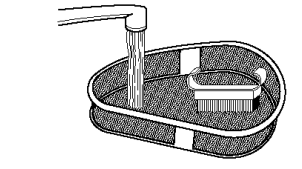Documents: Go to download!
- Owner's manual - (English)
User Manual Kenmore LAUNDRY CENTER Washer- Electric Dryer
WASHER USE

Staring Your Washer
The following is a guide to starting your washer. Periodic references to other sections of this manual provide more detailed information.
- Pour measured powdered or liquid detergent into the washer. If desired, add powdered or liquid color safe bleach.
- Place a load of sorted clothes in the washer.
- Load evenly to maintain washer balance. Mix large and small items. See “Loading.”
- Items should move easily through the wash water. Overloading can cause poor cleaning.
- Close the washer lid.
- Turn the WATER LEVEL selector knob to the correct setting for your wash load and the type of fabric being washed
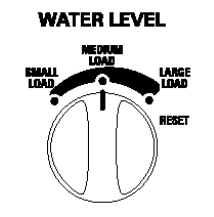
- Choose a load size that allows the load to move freely for best fabric care. See “Loading.”
- You may change the load size selection after the washer has started filling by turninq the selector to a different setting.
- Set the WATER TEMP selector to the correct setting for the type of fabric and soils being washed.
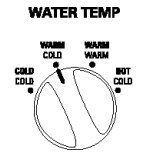
Use the warmest water safe for the fabric. Follow garment label instructions.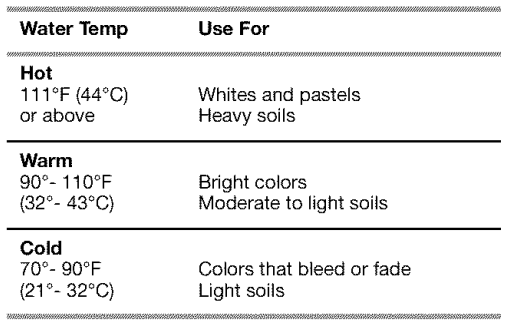
NOTE: In wash water temperatures colder than 70°F (21 °C), detergents do not dissolve well. Soils can be difficult to remove. Some fabrics can retain wear wrinkles and have increased pilling (the formation of small lint-like balls on the surface of garments). - Push in the Cycle Control knob and turn it clockwise to the wash cycle you want. Pull out the Cycle Control knob to start the washer.
To stop or restart your washer:
- To stop the washer at any time, push in the Cycle Control knob.
- To restart the washer, close the lid (if open) and pull out the Cycle Control knob.
Cycles
This section describes the available wash cycles and will help you make the best cycle selections for your wash loads. Each cycle is designed for different types of fabric and soil levels.
- The washer pauses briefly throughout each cycle. These pauses are normal. Refer to "Normal Sounds" for sounds you may hear during a wash cycle.
- Refer to "Understanding Washer Cycles" to learn what happens during a wash cycle.
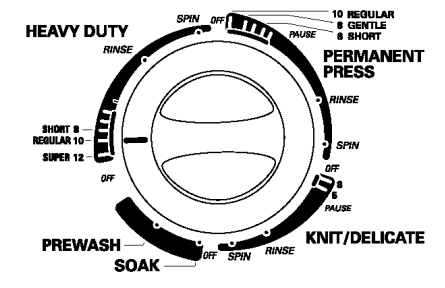
Heavy Duty
Use this cycle for sturdy or heavily soiled loads. Wash combines fast speed agitation and fast spin speeds.
- Use the Super or Regular settings for heavily soiled and sturdy fabrics.
- Use the Short setting for light soil and delicate fabrics.
Permanent Press
The Permanent Press Cycle includes a load cooling process that reduces wrinkling. Wash combines fast and slow speed agitation and slow spin speeds.
When the timer reaches Pause, the washer will drain and pause for approximately 2 minutes while some of the wash water is drained and replaced with rinse water.
Knit/Delicate
Use this cycle for lingerie and loosely knit items. Partway through the cycle the washer pauses and soaks the load for more gentle care of lightly soiled delicate items. Wash combines slow speed agitation for gentle soil removal and slow spin speeds to reduce wrinkling.
Soak
The Soak cycle features 4 minutes of agitation followed by an unlimited soak time to help remove heavy soils and stains that need pretreatment. You will need to reset the washer to a SPIN setting to remove water.
- The Soak cycle should be followed by the Heavy Duty or Permanent Press or Prewash cycle with additional detergent.
NOTE: Hot water is not recommended for soaking. It may set some stains.
Prewash
Use this cycle to get up to 4 minutes of agitation to help remove heavy soils and stains that need pretreatment
- The Prewash cycle should be followed by the Heavy Duty or Permanent Press cycle with additional detergent.
Rinse ad Spin
When using extra detergent for heavily soiled clothes, or washing special-care items, you may find an extra rinse and spin is needed.
- Push in the Cycle Control knob and turn it clockwise to any of the RINSE settings.
- For fast agitation and spin, use the Heavy Duty cycle.
- For slow agitation and spin, use the Permanent Press cycle.
- Set the WATER LEVEL and WATER TEMP controls to the desired setting.
- Pull out the Cycle Control knob. The washer fills to the selected load size, agitates, drains, and spins.
Drain and Spin
A drain and spin may help shorten drying times for some heavy fabrics or special-care items by removing excess water.
- Push in the Cycle Control knob and turn it clockwise to any of the SPIN settings.
- For a fast spin, use the Heavy Duty cycle.
- For a slow spin, use the Permanent Press cycle.
- Pull out the Cycle Control knob. The washer drains, then spins.
Understanding Washeer Cycles
When the Cycle Control knob is set to a number and pulled out, the washer fills (to the selected load size) before agitation and timing start. The washer begins agitating immediately after filling; agitation occurs with the washer lid up or down.
During agitation, the agitator creates a continuous rollover action that provides a thorough cleaning of the wash load.

After agitation starts, the Cycle Control knob turns clockwise until it points to an Off area and the cycle ends.
NOTE: The washer pauses briefly throughout each cycle. These pauses are normal for washer operation.
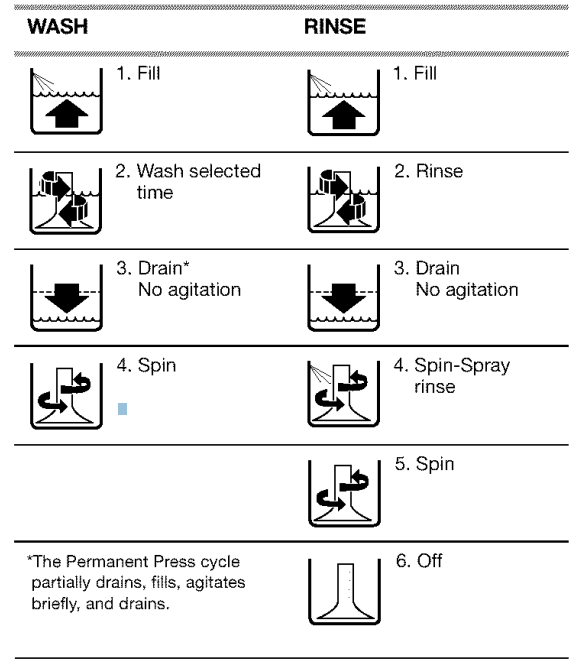
Normal Sounds
As with any new product, you will hear sounds that you are not accustomed to. You may hear various sounds occurring during the washing, rinsing, and spinning process. Between changes in wash actions, there will be momentary pauses. You will hear water spraying and splashing during the wash and rinse cycles. You may hear air being pulled through the pump during the end of draining or gears changing when the cycle changes. These sounds are part of normal washer operation.
LAUNDRY TIPS
Preparing clothes for washing
Follow these recommendations to help you prolong the life of your garments.
- Close zippers, snaps, and hooks to avoid snagging other items. Remove pins, buckles, and other hard objects to avoid scratching the washer interior. Remove non-washable trim and ornaments.
- Empty pockets and turn them inside out.
- Turn down cuffs, brush away lint and dirt.
- Turn synthetic knits inside out to avoid pilling.
- Tie strings and sashes so they will not tangle.
- Mend tears, loose hems, and seams.
- Treat spots and stains.
- Stained or wet garments should be washed promptly for best results.
Sorting
- Separate heavily soiled items from lightly soiled ones, even if they would normally be washed together. Separate lint givers (towels, chenille) from lint takers (corduroy, synthetics, permanent press). When possible, turn lint givers inside out.
- Separate dark colors from light colors, colorfast items from non-colorfast items.
- Sort by fabric and construction (sturdy cottons, knits, delicate items).
Loading
Loading suggestions (maximum size loads)
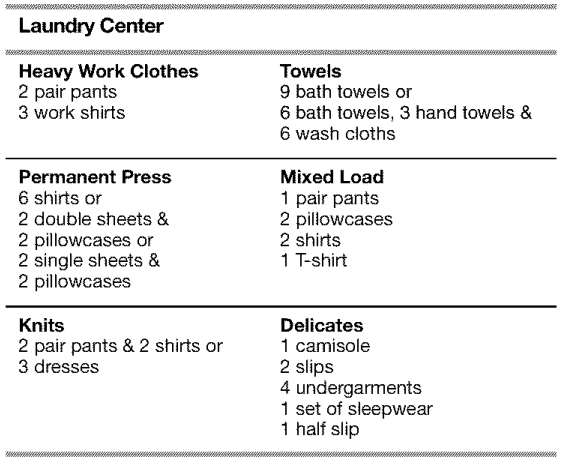
DRYER USE
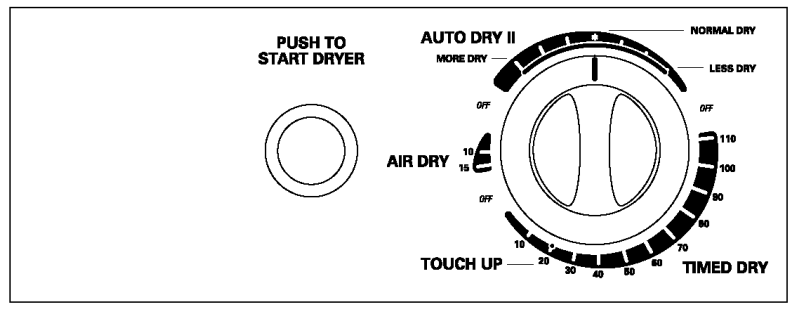
Staring Your Dryer
Before using your dryer, wipe the dryer drum with a damp cloth to remove dust from storing and shipping.
- Check the lint screen, clean if needed. See "Cleaning the Lint Screen."
- Load clothes loosely into the dryer and close the door. Do not pack the dryer. Allow space for clothes to tumble freely.
- Turn the Cycle Control knob to the recommended cycle and temperature for the type of load being dried. See "Drying, Cycle and Temperature Tips."
- Press the PUSH TO START DRYER button.

Stopping and Restarting
You can stop your dryer anytime during a cycle.
To stop your dryer
Open the dryer door or turn the Cycle Control knob to OFR
NOTE: The Cycle Control knob should point to an Off area when the dryer is not in use.
To restart your dryer
- Close the door.
- Select a new cycle and temperature (if desired).
- Press the PUSH TO START DRYER button.
Loading
Load clothes loosely into the dryer. Do not pack the dryer. Allow space for clothes to tumble freely. The following chart shows examples of balanced loads that would allow for proper tumbling.

Drying, Cycle and temperature tips
Select the correct cycle and temperature for your load.
Drying tips
- Follow care label directions when they are available.
- If you use fabric softener sheets, use only ones labeled as dryer safe. Follow package instructions.
- Remove the load from the dryer as soon as tumbling stops to reduce wrinkling. This is especially important for permanent press, knits, and synthetic fabrics.
Cycle and temperature tips
- Dry most loads using the Normal Dry setting (*).
- Use a More Dry setting for drying heavyweight items such as towels and work clothes.
- Use a Normal Dry setting for drying medium weight items, such as sheets, underwear, permanent press fabrics, and some knits.
- Use a Less Dry setting for drying lightweight items such as lingerie, blouses, dresses, and some knits.
- Use a no heat (air) setting for rubber, plastic or heat sensitive fabrics.
- Line dry bonded or laminated fabrics.
If you are unsure of the temperature to select for a load, select a lower setting rather than a higher setting.
NOTE: If you have questions about drying temperatures for various loads, refer to the care label directions.
Cycles

Auto Dry II
Use this cycle to dry most loads. Dryness is determined by thermostats that react to the amount of moisture in the air exhausted from the dryer. Moist air indicates clothes are damp.
Dry air indicates that moisture has been removed.
This cycle includes a 10 minute (approximately) cool down period at the end of the cycle to make clothes easier to handle and reduce wrinkling.
Dry most loads using the Normal Dry (*) setting. When the cycle ends, check the dryness of the load.
- If the load is drier than you like, select a setting closer to LESS DRY the next time you dry a similar load.
- If the load is not as dry as you like, complete drying using the Timed Dry cycle. The next time you dry a similar load, select a setting closer to MORE DRY.
NOTE: Drying time with an automatic cycle varies according to the type of fabric, size of load, and temperature setting. See "Drying, Cycle and Temperature Tips."
Timed Dry
Use this cycle to complete drying if items are still damp after the Auto Dry II cycle. Timed Dry is also useful for heavyweight and bulky items, such as bedspreads, work clothes, and large loads that require a long drying time. Use this cycle to get up to 110 minutes of heated drying time. The heating cycle is followed by a 10 minute (approximately) cool down period.
Touch Up
Use this cycle to smooth synthetic and permanent press clothes that are clean but wrinkled from being crowded in a closet or suitcase. This setting provides approximately 10 minutes of heated tumbling followed by a 10 minute (approximately) cool down period. Remove clothes immediately when tumbling stops
Air Dry
Use the Air Dry cycle for items that require drying without heat such as rubber, plastic and heat sensitive fabrics. This chart shows examples of items that can be dried using an air cycle.
Type of Load | 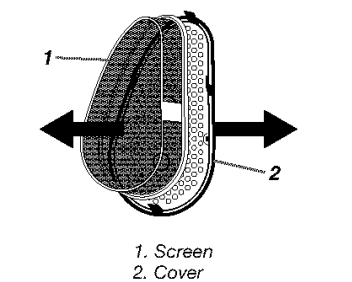 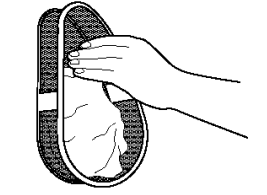 IMPORTANT:
As needed cleaning Laundry detergent and fabric softener residue can build up on the lint screen. This buildup can cause longer drying times for your clothes, or cause the dryer to stop before your load is completely dry. The screen is probably clogged if lint falls off the screen. Clean the lint screen (as outlined following) every 6 months, or more frequently if it becomes clogged due to a residue buildup. To wash
Cleaning The Dryer InteriorTo clean dryer drum
NOTE: Garments which contain unstable dyes, such as denim blue jeans or brightly colored cotton items, may discolor the dryer interior. These stains are not harmful to your dryer and will not stain future loads of clothes. Dry unstable dye items inside out to prevent dye transfer. Removing Accumulated LintFrom Inside the Dryer Cabinet Lint should be removed every 2 years, or more often, depending on dryer usage. Cleaning should be done by a qualified person. From the Exhaust Vent Lint should be removed every 2 years, or more often, depending on dryer usage. Vacation, Storage, and Moving CareInstall and store your laundry center where it will not freeze. Because some water may stay in the hoses, freezing can damage your laundry center. If storing or moving your laundry center during freezing weather, winterize it. Non-use or vacation care Operate your laundry center only when you are at home. If you will be on vacation or not using your laundry center for an extended period of time, you should:
To winterize laundry center
To use laundry center again
To transport the laundry center
Re-installing your laundry center
TROUBLESHOOTING WASHERFirst try the solutions suggested here and possibly avoid • the cost of a service call… Washer won’t fill, rinse or agitate
Is the power cord plugged in or power connected? Is the indicator on the Cycle Control knob properly lined up with a cycle? Turn the Cycle Control knob to the right slightly and pull to start. Are the water inlet valve screens clogged? Are both the hot and cold water faucets turned on? Is the water inlet hose kinked?
The top of the agitator is much higher than the highest water level. This creates a perception that the washer is not filling completely. This is normal. Washer stops
Is the power cord plugged in or power connected? Is the indicator on the Cycle Control knob properly lined up with a cycle? Turn the Cycle Control knob to the right slightly and pull to start. Are the water inlet valve screens clogged? Are both the hot and cold water faucets turned on? Is the water inlet hose kinked?
Check your electrical source or call an electrician.
If problem continues, call an electrician.
Do not use an extension cord.
Wash smaller loads.
The washer pauses for about 2 minutes in the Permanent Press cycle. Allow the cycle to continue. Washer won’t drain or spin
See “Installation Instructions” for proper installation of drain hose.
The lid must be closed during operation.
Always measure detergent. Follow manufacturer’s directions. If you have very soft water, you might need to use less detergent.
Check your electrical source or call an electrician. Do not use an extension cord. Washer continues to fill or drain, or the cycle seems stuck
The top of the hose must be higher than the water level in the washer for proper operation (see “Installation Instructions").
The drain hose should be loose yet fit securely. Do not seal the drain hose with tape. The hose needs an air gap (see “Installation Instructions”). Washer makes noise
The wash load should be balanced and not overloaded. The laundry center must be level. Ensure leveling legs are installed (see “Installation Instructions").
See “Installation Instructions.”
These are normal washer noises. Washer leaks
Are the fill hoses tight? Are the fill hose washers properly seated? Is the drain hose clamp properly installed? See “Installation Instructions.”
Sink and standpipe must be able to handle 17 gal. (64 L) of water per minute.
Center the tub before starting the washer. The wash load should be balanced and not overloaded. The fill or spray rinses can deflect off the load. The laundry center must be level. Ensure leveling legs are installed (see “Installation Instructions”).
Washer basket is crooked
The wash load should be balanced and not overloaded. Push the basket to the center before starting wash.
The wash load should be balanced and not overloaded. The laundry center must be level. Ensure leveling legs are installed (see “Installation Instructions").
This is normal. Agitator operation
This is normal. Load too wet
Select a cycle with a higher spin speed (if available).
Cold rinses leave loads wetter than warm rinses. This is normal. Residue or lint on load
Sort lint givers (towels, chenille) from lint takers (corduroy, synthetics). Also sort by color.
The wash load must be balanced and not overloaded. Lint can be trapped in the load if overloaded. Wash smaller loads.
Was paper or tissue left in the pockets? Did you use enough detergent? Follow manufacturer’s directions. Use enough detergent to hold the lint in the water. Is your water colder than 70°F (21 °C)? Wash water colder than 70°F (21 °C) may not completely dissolve the detergent. Stains on load
Measure detergent and fabric softener. Use enough detergent to remove soil and hold it in suspension. Dilute fabric softener and add to the rinse portion of a cycle only. Do not drip fabric softener on clothes.
You may need to install an iron filter.
Sort dark clothes from whites and lights.
To avoid dye transfer, unload the washer as soon as it stops. Load is wrinkled
Use a cycle with a low spin speed to reduce wrinkling.
Unload the washer as soon as it stops.
The wash load must be balanced and not overloaded. Loads should move freely during washing.
If safe for the load, use warm wash water.
Check to be sure the hot and cold water hoses are connected to the right faucets (see “Installation Instructions”). Load is tangled or twisted
The wash load must be balanced and not overloaded. Loads should move freely during washing.
Drop items loosely into the washer. Do not wrap items around the agitator. Gray whites, dingy colors
Dye transfer can occur when mixing whites and colors in a load. Sort dark clothes from whites and lights.
Use warm washes if safe for the load.
Use more detergent for washing heavy soils in cold or hard water.
Check to be sure the hot and cold water hoses are connected to the right faucets (see “installation Instructions”). Garment damage
Were sharp items removed from pockets before washing? Empty pockets, zip zippers, snap or hook fasteners before washing. Were strings and sashes tied to prevent tangling? Were items damaged before washing? Mend rips and broken threads in seams before washing.
The wash load must be balanced and not overloaded. Loads should move freely during washing.
Do not pour chlorine bleach directly on load. Wipe up bleach spills. Undiluted bleach will damage fabrics.
TROUBLESHOOTING DRYERFirst try the solutions suggested here and possibly avoid the cost of a service call... Clothes are not drying satisfactorily
Is the lint screen clogged with lint? Is the exhaust vent or outside exhaust hood clogged with lint, restricting air movement? Run the dryer for 5-10 minutes. Hold your hand under the outside exhaust hood to check air movement, if you do not feel air movement, clean exhaust system of lint or replace exhaust vent with heavy metal or flexible metal vent (see “Installation Instructions”). Is the exhaust vent crushed or kinked? Replace with heavy metal or flexible metal vent (see “Installation Instructions”). Has a fuse blown, or a circuit breaker tripped? Electric dryers use 2 household fuses or breakers. The drum may be turning but you may not have heat. Has an air dry cycle been selected? Select the right cycle for the types of garments being dried (see “Drying, Cycle and Temperature Tips”). Are fabric softener sheets blocking the grille? Use only one fabric softener sheet and only use it once.
Proper operation of dryer cycles requires temperatures above 45°F (7°C).
Expect longer drying times with items rinsed in cold water and with items that hold moisture (cottons).
Separate the load to tumble freely. Dryer will not run
Is the power cord plugged in or power connected? Has a fuse blown, or has a circuit breaker tripped? Was a regular fuse used? Use a time-delay fuse. Is the dryer door firmly closed? Was the START button firmly pressed? Is a cycle selected? Unusual sounds
If the dryer hasn’t been used for a while, there may be a thumping sound during the first few minutes of operation. Lint on load
Clean lint screen. Check for air movement.
Sort lint givers (towels, chenille) from lint takers (corduroy, synthetics). Also sort by color.
Dry smaller loads so lint can be carried to the lint screen.
Use correct dryer settings for load type. Overdrying can cause lint-attracting static electricity (see “Drying, Cycle, and Temperature Tips”). Was paper or tissue left in pockets?
Pilling (surface fuzz) is caused by normal wear and laundering. Stains on load or color change
Add dryer fabric softener sheets at the beginning of the cycle. Fabric softener sheets added to a partially-dried load can stain your garments.
Items should be clean before being dried.
Sort light colors from dark colors. Sort colorfast items from non-colorfast items. Items shrinking
Dry smaller loads that can tumble freely.
Check the manufacturer’s care label. Match dryer setting to load type (see “Drying, Cycle, and Temperature Tips”). Loads are wrinkled
Dry smaller loads that can tumble freely.
Check the manufacturer’s care label. Match dryer setting to load type (see “Drying, Cycle, and Temperature Tips”). Odors
If so, ventilate the area. When the odors or fumes are gone from the area, re-wash and dry the clothing.
The new electric heating element may have an odor. The odor will be gone after the first cycle. Garment damage
Were zippers, snaps, and hooks left open? Were strings and sashes tied to prevent tangling? Were care label instructions followed? Were items damaged before drying? See other models: 10673854302 66562612200 72180403400 72180012000 66516352301
Kenmore 11088752793 | File type: PDF | Filename: 11088752793.pdf | Size: 1.88 MB | Language: English
Download User Manual Kenmore 11088752793 Questions and AnswersKenmore Owner manual PDF of Kenmore 11088752793 24-Inch Wide LAUNDRY CENTER Washer- Electric Dryer.Use manuals file type: PDF. Kenmore - Washers & Dryers Related Products |
